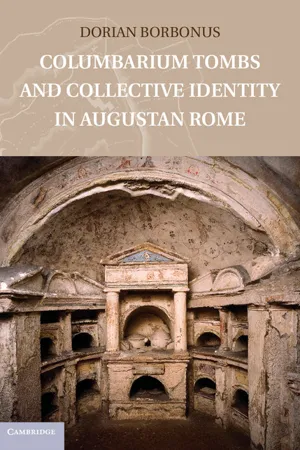
- English
- PDF
- Available on iOS & Android
Columbarium Tombs and Collective Identity in Augustan Rome
About this book
Columbarium tombs are among the most recognizable forms of Roman architecture and also among the most enigmatic. The subterranean collective burial chambers have repeatedly sparked the imagination of modern commentators, but their origins and function remain obscure. Columbarium Tombs and Collective Identity in Augustan Rome situates columbaria within the development of Roman funerary architecture and the historical context of the early Imperial period. Contrary to earlier scholarship that often interprets columbaria primarily as economic burial solutions, Dorian Borbonus shows that they defined a community of people who were buried and commemorated collectively. Many of the tomb occupants were slaves and freed slaves, for whom collective burial was one strategy of community building that counterbalanced their exclusion in Roman society. Columbarium tombs were thus sites of social interaction that provided their occupants with a group identity that, this book shows, was especially relevant during the social and cultural transformation of the Augustan era.
Frequently asked questions
- Essential is ideal for learners and professionals who enjoy exploring a wide range of subjects. Access the Essential Library with 800,000+ trusted titles and best-sellers across business, personal growth, and the humanities. Includes unlimited reading time and Standard Read Aloud voice.
- Complete: Perfect for advanced learners and researchers needing full, unrestricted access. Unlock 1.4M+ books across hundreds of subjects, including academic and specialized titles. The Complete Plan also includes advanced features like Premium Read Aloud and Research Assistant.
Please note we cannot support devices running on iOS 13 and Android 7 or earlier. Learn more about using the app.
Information
Table of contents
- Cover
- Half-title
- Title
- Copyright
- Dedication
- Contents
- List of Illustrations
- List of Tables
- List of Abbreviations
- Acknowledgments
- Introduction
- Chapter One Studying Columbaria as a Historical Phenomenon
- Chapter Two Tradition and Innovation in the Architectural Design of Columbaria
- Chapter Three Making and Breaking the Rules: The Use and Evolution of Columbaria
- Chapter Four Reading between the Lines: The Vocabulary of Columbarium Epitaphs
- Chapter Five Finding Niches in Society: The Occupants
- Conclusion
- Appendix A Archaeological Catalog
- Appendix B Summary of Epigraphic Data
- Appendix C Glossary
- Notes
- Bibliography
- Index